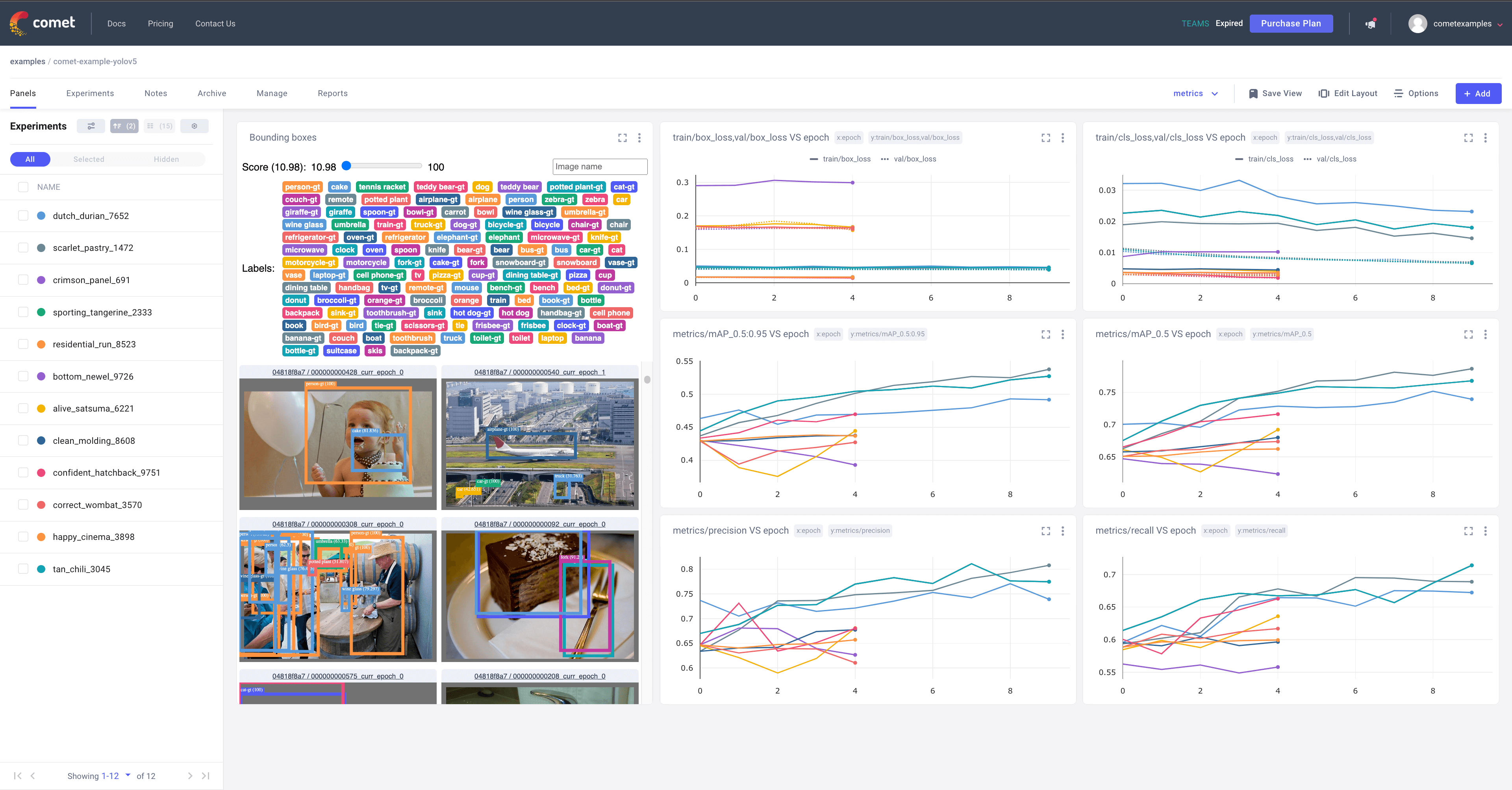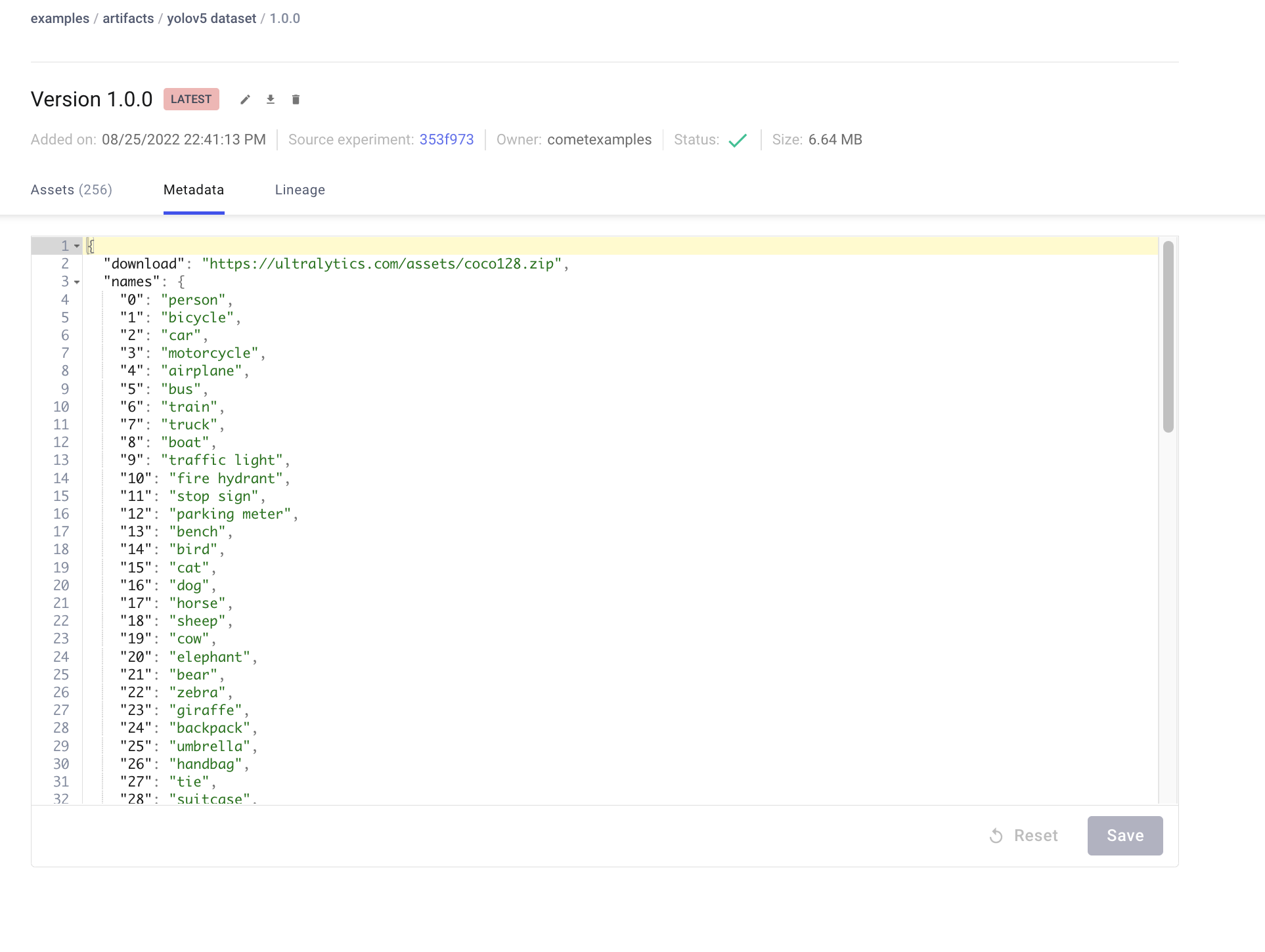12 KiB

Using Ultralytics YOLOv5 with Comet
Welcome to the guide on integrating Ultralytics YOLOv5 with Comet! Comet provides powerful tools for experiment tracking, model management, and visualization, enhancing your machine learning workflow. This document details how to leverage Comet to monitor training, log results, manage datasets, and optimize hyperparameters for your YOLOv5 models.
🧪 About Comet
Comet builds tools that help data scientists, engineers, and team leaders accelerate and optimize machine learning and deep learning models.
Track and visualize model metrics in real-time, save your hyperparameters, datasets, and model checkpoints, and visualize your model predictions with Comet Custom Panels! Comet ensures you never lose track of your work and makes it easy to share results and collaborate across teams of all sizes. Find more information in the Comet Documentation.
🚀 Getting Started
Follow these steps to set up Comet for your YOLOv5 projects.
Install Comet
Install the necessary Python package using pip:
pip install comet_ml
Configure Comet Credentials
You can configure Comet in two ways:
-
Environment Variables: Set your credentials directly in your environment.
export COMET_API_KEY=<Your Comet API Key> export COMET_PROJECT_NAME=<Your Comet Project Name> # Defaults to 'yolov5' if not setFind your API key in your Comet Account Settings.
-
Configuration File: Create a
.comet.configfile in your working directory with the following content:[comet] api_key=<Your Comet API Key> project_name=<Your Comet Project Name> # Defaults to 'yolov5' if not set
Run the Training Script
Execute the YOLOv5 training script. Comet will automatically start logging your run.
# Train YOLOv5s on COCO128 for 5 epochs
python train.py --img 640 --batch 16 --epochs 5 --data coco128.yaml --weights yolov5s.pt
That's it! Comet automatically logs hyperparameters, command-line arguments, and training/validation metrics. Visualize and analyze your runs in the Comet UI. For more details on training, see the Ultralytics Training documentation.

✨ Try an Example!
Explore a completed YOLOv5 training run tracked with Comet:
Run the example yourself using this Google Colab Notebook:
📊 Automatic Logging
Comet automatically logs the following information by default:
Metrics
- Losses: Box Loss, Object Loss, Classification Loss (Training and Validation).
- Performance: mAP@0.5, mAP@0.5:0.95 (Validation). Learn more about these metrics in the YOLO Performance Metrics guide.
- Precision and Recall: Validation data metrics.
Parameters
- Model Hyperparameters: Configuration used for the model.
- Command Line Arguments: All arguments passed via the CLI.
Visualizations
- Confusion Matrix: Model predictions on validation data, useful for understanding classification performance (Wikipedia definition).
- Curves: PR and F1 curves across all classes.
- Label Correlogram: Correlation visualization of class labels.
⚙️ Advanced Configuration
Customize Comet's logging behavior using command-line flags or environment variables.
# Environment Variables for Comet Configuration
Refer to the Comet documentation for more configuration options.
Logging Checkpoints with Comet
Model checkpoint logging to Comet is disabled by default. Enable it using the --save-period argument during training. This saves checkpoints to Comet at the specified epoch interval.
python train.py \
--img 640 \
--batch 16 \
--epochs 5 \
--data coco128.yaml \
--weights yolov5s.pt \
--save-period 1 # Save checkpoint every epoch
Checkpoints will appear in the "Assets & Artifacts" tab of your Comet experiment. Learn more about model management in the Comet Model Registry documentation.
Logging Model Predictions
By default, model predictions (images, ground truth labels, bounding boxes) for the validation set are logged. Control the logging frequency using the --bbox_interval argument, which specifies logging every Nth batch per epoch.
Note: The YOLOv5 validation dataloader defaults to a batch size of 32. Adjust --bbox_interval accordingly.
Visualize predictions using Comet's Object Detection Custom Panel. See an example project using the Panel here.
python train.py \
--img 640 \
--batch 16 \
--epochs 5 \
--data coco128.yaml \
--weights yolov5s.pt \
--bbox_interval 2 # Log predictions every 2nd validation batch per epoch
Controlling the Number of Prediction Images
Adjust the maximum number of validation images logged using the COMET_MAX_IMAGE_UPLOADS environment variable.
env COMET_MAX_IMAGE_UPLOADS=200 python train.py \
--img 640 \
--batch 16 \
--epochs 5 \
--data coco128.yaml \
--weights yolov5s.pt \
--bbox_interval 1 # Log every batch
Logging Class Level Metrics
Enable logging of mAP, precision, recall, and F1-score for each class using the COMET_LOG_PER_CLASS_METRICS environment variable.
env COMET_LOG_PER_CLASS_METRICS=true python train.py \
--img 640 \
--batch 16 \
--epochs 5 \
--data coco128.yaml \
--weights yolov5s.pt
💾 Dataset Management with Comet Artifacts
Use Comet Artifacts to version, store, and manage your datasets.
Uploading a Dataset
Upload your dataset using the --upload_dataset flag. Ensure your dataset follows the structure described in the Ultralytics Datasets documentation and the dataset config YAML file matches the format of coco128.yaml (see the COCO128 dataset docs).
python train.py \
--img 640 \
--batch 16 \
--epochs 5 \
--data coco128.yaml \
--weights yolov5s.pt \
--upload_dataset # Upload the dataset specified in coco128.yaml
View the uploaded dataset in the Artifacts tab of your Comet Workspace.

Preview data directly in the Comet UI.

Artifacts are versioned and support metadata. Comet automatically logs metadata from your dataset yaml file.

Using a Saved Artifact
To use a dataset stored in Comet Artifacts, update the path in your dataset yaml file to the Artifact resource URL:
# contents of artifact.yaml
path: "comet://<workspace_name>/<artifact_name>:<artifact_version_or_alias>"
train: images/train # Adjust subdirectory if needed
val: images/val # Adjust subdirectory if needed
# Other dataset configurations...
Then, pass this configuration file to your training script:
python train.py \
--img 640 \
--batch 16 \
--epochs 5 \
--data artifact.yaml \
--weights yolov5s.pt
Artifacts track data lineage, showing which experiments used specific dataset versions.

🔄 Resuming Training Runs
If a training run is interrupted (e.g., due to connection issues), you can resume it using the --resume flag with the Comet Run Path (comet://<your_workspace>/<your_project>/<experiment_id>).
This restores the model state, hyperparameters, arguments, and downloads necessary Artifacts, continuing logging to the existing Comet Experiment. Learn more about resuming runs in the Comet documentation.
python train.py \
--resume "comet://<your_workspace>/<your_project>/<experiment_id>"
🔍 Hyperparameter Optimization (HPO)
YOLOv5 integrates with the Comet Optimizer for easy hyperparameter sweeps and visualization. This helps in finding the best set of parameters for your model, a process often referred to as Hyperparameter Tuning.
Configuring an Optimizer Sweep
Create a JSON configuration file defining the sweep parameters, search strategy, and objective metric. An example is provided at utils/loggers/comet/optimizer_config.json.
Run the sweep using the hpo.py script:
python utils/loggers/comet/hpo.py \
--comet_optimizer_config "utils/loggers/comet/optimizer_config.json"
The hpo.py script accepts the same arguments as train.py. Pass additional fixed arguments for the sweep:
python utils/loggers/comet/hpo.py \
--comet_optimizer_config "utils/loggers/comet/optimizer_config.json" \
--save-period 1 \
--bbox_interval 1
Running a Sweep in Parallel
Execute multiple sweep trials concurrently using the comet optimizer command:
comet optimizer -j \
utils/loggers/comet/hpo.py < num_workers > utils/loggers/comet/optimizer_config.json
Replace <num_workers> with the desired number of parallel processes.
Visualizing HPO Results
Comet offers various visualizations for analyzing sweep results, such as parallel coordinate plots and parameter importance plots. Explore a project with a completed sweep here.

🤝 Contributing
Contributions to enhance the YOLOv5-Comet integration are welcome! Please see the Ultralytics Contributing Guide for more information on how to get involved. Thank you for helping improve this integration!